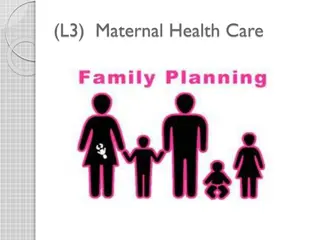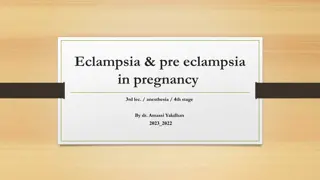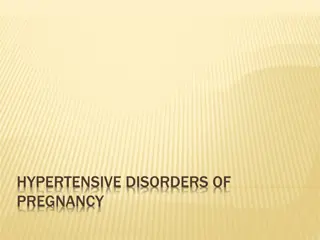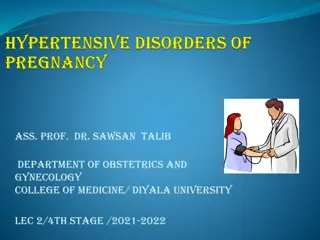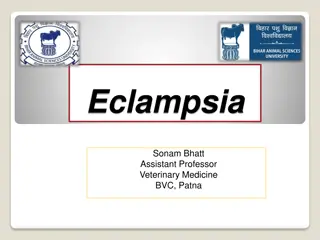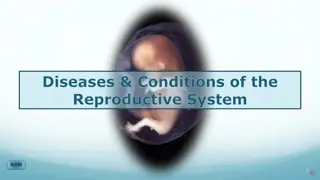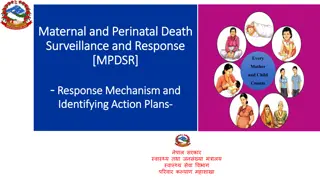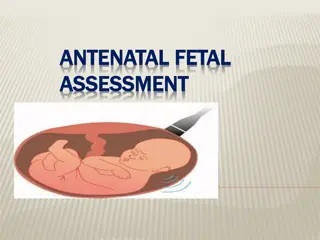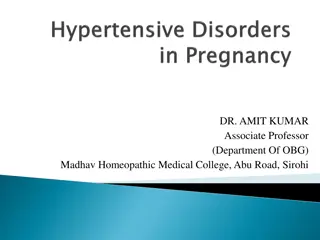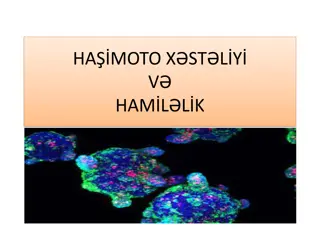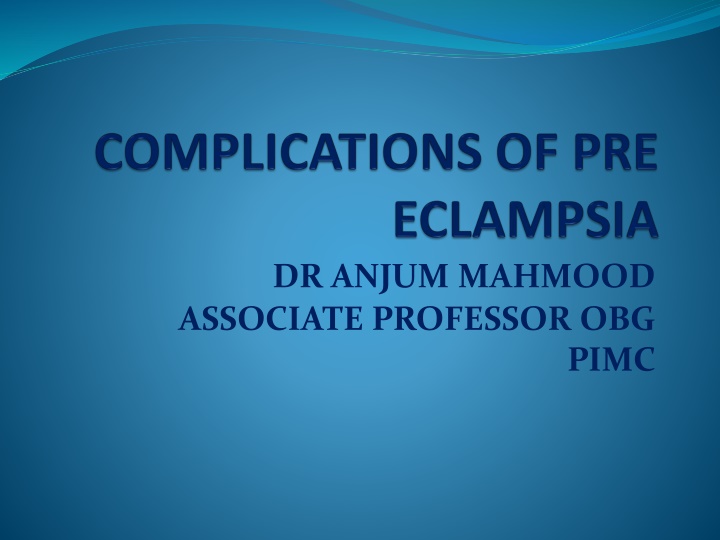
Eclampsia and Its Complications in Pregnancy
Learn about the various complications of eclampsia, including maternal and fetal risks, early warning signs, management protocols, and the pathophysiology behind this condition. Discover the incidence rates and associated morbidity, emphasizing the importance of awareness and timely intervention to reduce maternal mortality.
Download Presentation

Please find below an Image/Link to download the presentation.
The content on the website is provided AS IS for your information and personal use only. It may not be sold, licensed, or shared on other websites without obtaining consent from the author. If you encounter any issues during the download, it is possible that the publisher has removed the file from their server.
You are allowed to download the files provided on this website for personal or commercial use, subject to the condition that they are used lawfully. All files are the property of their respective owners.
The content on the website is provided AS IS for your information and personal use only. It may not be sold, licensed, or shared on other websites without obtaining consent from the author.
E N D
Presentation Transcript
DR ANJUM MAHMOOD ASSOCIATE PROFESSOR OBG PIMC
LEARNING OBJECTIVES To understand about various complications of pre eclampsia To understand the incidence and risk factors for onset of eclampsia To be able to understand the early warning signs of eclampsia To be able to understand the step wise approach in management protocol .
MATERNAL COMPLICATIONS Eclampsia HELLP syndrome Renal failure Hepatic failure Pulmonary edema DIC Preterm labour Stroke ---- CVA Cerebral edema Blindness ---- retinal detachment Death
FETAL COMPLICATIONS IUGR Fetal distress Problems related to prematurity IUD
ECLAMPSIA Eclampsia is a complication of severe pre-eclampsia It is characterized by occurrence of one or more grand mal seizures (tonic clonic fits) and/or unexplained coma in the setting of pregnancy induced hypertension or post natal in a woman with signs and symptoms of pre-eclampsia , in the absence of other neurological conditions.
Occurs after 20thweek of gestation, intranatal or within 72 hrs of post natal. But has been reported till day 23 postnatal Eclampsia in the absence of proteinureaand hypertension has been reported in 38% of cases and can be without hypertension in 16% of cases The UK obstetric surveillance system(UKOSS) reports the incidence of eclampsia as 27.5 cases per 100,000 pregnancies, with case fatality rate to be 3.1% Eclampsia is associated with significant CNS morbidity Cerebral haemorrhage is the most common cause of death 3.4% of women with severe pre-eclampsiawill have a convulsion Eclampsia is the number one cause of in-hospital maternal death
PATHOPHYSIOLOGY There are several theories and etiologic mechanisms. Vasospasm theory: Most favoured theory Vasospasms vasoconstriction resistance arterial BP Eclampsia: Cerebral arterial vasospasm cerebral edema or infarction and/or cerebral hemorrhage
Eclampsia Convulsions in a pregnant woman with hypertention, with no previous history of convulsion Diastolic blood pressure 90 mm Hg or more after 20 weeks gestation Proteinuria 2+ or more Is usually but not always preceded by pre-eclampsia Rarely eclampsia can occur in patients with normal BP Signs and symptoms sometimes present: Epigastric tenderness Headache Visual changes Hyperreflexia Pulmonary edema Oliguria Coma (Unconscious) 8
RISK FACTORS SAME AS PRE ECLAMPSIA Nulliparity Family History Previous poor obstetrical outcome Multiple pregnancy H.mole Fetal Hydrops Primigravida/teenage pregnancy Older than 35 Low socioeconomic status
Vascular and connective tissue disorders Gestational Diabetes SLE Obesity Chronic HTN Renal diseases Thrombophilia / APS
CLINICAL MANIFESTATION Eclampsia manifest as seizures lasting for 60-75 seconds It has 4 phases Aura Tonic Clonic Relaxation/ coma 1. 2. 3. 4.
Patients face becomes distorted. Protrusion of eyes Foaming at angles of mouth Respiration caeses for duration of seizures followed by gen. muscular contraction Facial twitching Rigid body followed by chronic phase in which body is arched between head and toe and muscles relax and contract in rapid sequence with hyperventilation followed by unconciousness of variable period
After coma patient may regain consciousness but may remain irritated. She doesn t have any recollection of seizures Seizures related complications include; Tongue bitting Head trauma Broken bones Aspiration
Seizures in 100% ( 70% ANTENATAL, 50% INTRAPARTUM, 55% POSTNATAL) Headache 80% General Edema 50% Vision disturbance 40% Right upper quadrant abdominal pain Hyperactive reflexes 20% Amnesia and mental changes 20% Marked proteinuria Generalised edema Papilloedema Oliguria/anuria Neurological defecit Apprehension Amnesia and mental changes 20%
D/D Intracranial hemorrhage Cerebrovascular thrombosis Encephalopathy Head trauma Hyperaldosteronsism Hypoglycemia Meningitis Brain tumor Epilepsy Septicemia Stroke Metabolic disorders
INVESTIGATIONS CT Scan/ MRI Lumbar Puncture Serum electrolytes Urine R/E Complete blood count Coagulation profile Blood sugar RFTs/LFTs Platelet count Uric acid ECG/ EEG Ultrasound for fetal assessment
MANAGEMENT Call the senior for help and emergency alert team Admission to ICU Maintain ABC Sedation/Rest Cathetrization Left lateral position Wide bore I/V cannula Isotonic solution + 700ml for insensible loss Intake/output record Steroids Airway support Adequate oxygenation Anti-convulsant therapy WITH MAGNESIUM SULFATE . Loading dose of 4gm followed by 1gm /hour infusionfor till 24 hours after delivery
Delivery after stabilisation Anticonvulsants -MgSo4 -Phenytoin sodium -Diazepam/Lorezapam -Lytic cocktail (mixture of pethidine28mg, promethazine 7mg, chlorpromazine 7mg, given I/M or rectally) -Pentathol per rectal Antihypertensives -Hydralazine -Nifidepine -Lebatalol -Diuretics (only for pulmonary edema)
BP CONTROL Keep SBP between 140 -160 mm Hg and DBP between 90 - 110 mm Hg ?Why these levels: Avoid potential reduction in either uteroplacental blood flow or cerebral perfusion pressure Anti HPTs: Hydralazine, nifedipine, or labetalol Hydralazine 5 mg IV slowly every 5 min until blood pressure less than 110 mm Hg (goal is to have BP between 90 and 100 mm Hg) Repeat hourly as needed or give hydralazine 12.5 mg IM every 2 hours as needed.
An overview on MgSO4. Mechanism: Cerebral vasodilator reducing cerebral vasospasm ischemia (brain). Superior to other anti-convulsants used to control and prevent fits; Important part of management of eclampsia Recurrence rate after MgSO4 = 10 -15% Improves maternal and fetal outcome
Loading dose Give MgSO4 4 g (i.e. 20mls of 20% solution) + 200mls NS or sterile water I.V over 5 minutes Follow promptly with 10g (i.e. 20ml of 50% solution), 5g in each buttock as deep I.M with 1ml of 2% lignocaine in the same syringe Maintenance dose MgSO4 5 g (i.e. 10ml of 50% solution) + 1 ml lignocaine 2% 4 hourly in alternate buttocks. NOTE: IM inj. are painful and are complicated by local abscess formation in 0.5% of cases. The intravenous (IV) route is therefore preferred
Recurrent fits : Therapeutic dose may not have been reached Give 2g (i.e. 10ml of 20% solution) i.v. over 5 minutes Treatment duration: Continue for 24 hours after delivery or last convulsion, whichever occurs first
Causes loss of deep tendon reflexes, respiratory depression and ultimately respiratory arrest and oliguria Thus, before repeating MgSO4, ensure that; RR 16/min Patellar reflexes are present Urinary output is at least 30ml per hour over 4 hours Otherwise withhold or delay MgSO4 Keep antidote ready In case of respiratory arrest: Assist ventilation and administer calcium gluconate
Delivery should be within 6-8 hours of onset of fits Vaginal delivery is the safest mode of delivery Assessment Rule out any contraindications to SVD Bishop score If the cervix is favourable - induce labour Otherwise prepare for C/S
Management of labour 1st stage Relieve pain: pethidine 25 mg iv every 2-4 hours Augmentation of labour Monitor FHR, 2nd stage:Assist with vacuum extraction 3rd stage: Active management Oxytocin 10 IU i.m after delivery of anterior shoulder Cord traction Squeezing clots after delivery of the placenta
Management of labour If there is delay perform C/S Post delivery: Continue observation for at least 48 hrs post delivery Record and monitor BP and urine output for at least 48 hours after delivery, Keep the pt in hospital until BP stabilizes, Continue with aldomet PO until BP back to normal

